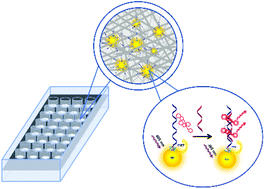Paper-based platform for detection by hybridization using intrinsically labeled fluorescent oligonucleotide probes on quantum dots†
Abstract
A paper-based platform was investigated in which the selective detection of oligonucleotide targets by hybridization was accomplished via the enhancement of fluorescence emission from intrinsically labeled DNA probes that were immobilized on the surface of quantum dots (QDs). Multiple copies of a derivative of thiazole orange, an intercalating dye known to form non-emissive dimers, were conjugated to single-stranded oligonucleotide probes. Dimerization resulted in the formation of H-aggregates where excitonic interactions led to the suppression of fluorescence. The hybridization of the oligonucleotide probe with a complementary target resulted in the enhancement of fluorescence emission as the dimers dissociated and the dyes preferentially intercalated with the duplex. The detection of oligonucleotide targets using this configuration eliminated the need for labeling the target strands, and fluorescence intensity was proportional to the extent of hybridization. In addition, the dye molecules were excited using Foerster Resonance Energy Transfer (FRET) from QD donors, which resulted in improved selectivity and allowed for ratiometric detection. A solution-phase hybridization assay based on similar operational principles has been previously reported, and this new work investigated the advantages offered for this transduction scheme using paper-based solid-phase substrates. QD-probe conjugates were immobilized in sufficient density on the paper matrix to provide for multiple-donor–multiple-acceptor interactions that resulted in a 20-fold enhancement of acceptor emission compared to the solution-based assay, providing a limit of detection of 0.1 pmol. The paper-based assay provided for the reduction of the time needed for sample preparation and data acquisition, demonstrated that transduction was possible in a complex matrix (goat serum) without compromising on the performance observed in buffer solution, and that oligonucleotides generated from standard PCR amplification could be detected.



 Please wait while we load your content...
Please wait while we load your content...